Doin’ it for the kids: Doctor Who Live
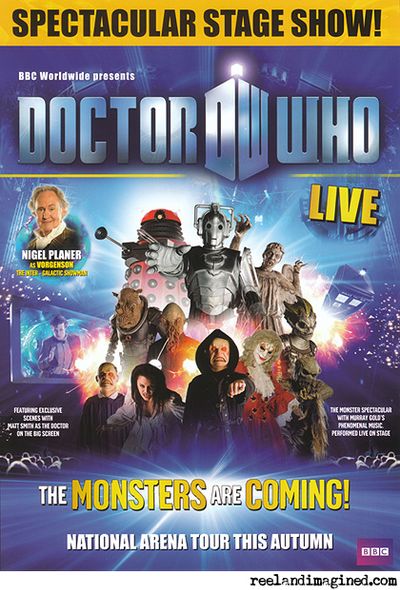
So runs the advertising blurb for the new Doctor Who stage show. I’ve long been suspicious of the cliché that has small children cowering behind items of furniture while Who is on telly. As a young fan in the early 1970s, I didn’t watch the show from behind the settee. Why would I? I thought that the series’ monsters were more likely to be lurking there. I avoided the area at all times, just like I avoided visiting the bottom of the garden, and I made sure that I was always out of the bathroom before the loo stopped flushing, particularly at night. Evil apple trees and toilet monsters are scarily real when you’re five.
I flash back to my early childhood this afternoon during the matinee performance of Doctor Who Live, at Wembley Arena. I say ‘performance’, but it’s actually the interval. I’m seated at the side, looking down on the main arena. To ready everyone for part two of the show, a few scarecrows (from the 2007 episodes Human Nature / The Family Of Blood) are wandering around the audience, in a lolloping, menacing manner. One little boy, aged around eight, is on his way out of the arena when one of the straw monsters lunges at him, sending him running back to the safety of his mum. This isn’t a panto reaction - the wee fella looks genuinely frightened. It’s heartwarming.
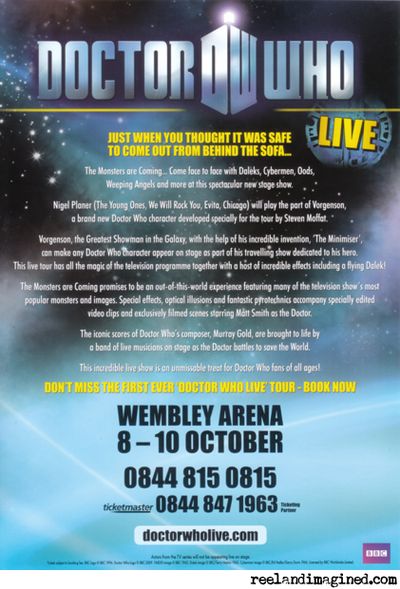
The idea appears to have spun off from the hugely successful Doctor Who Proms - events that sold out so fast, the only way to be sure of getting a ticket was to jump in the TARDIS and set the controls for the minute they went on sale (or should that be ‘go on sale’?).
As I note in a post from last year, Murray Gold’s work is at the heart of modern Doctor Who. This afternoon at Wembley, this music may not reach the peaks it scaled earlier this year in the Royal Albert Hall, with the National Orchestra of Wales and a full choir, but the arrangements do work very well. The more familiar pieces, in particular Amy’s Theme (played to a montage of Amy’s ‘best bits’ from her first season), certainly strike the same emotional chords. It speaks volumes that the biggest cheer this afternoon is reserved for Doctor Who Live’s musical director (and Doctor Who’s conductor and orchestrator), Ben Foster.
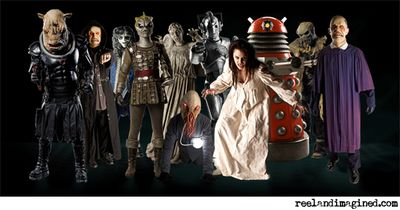
Fittingly, the answer lies in a spot of time-travel - right back to 1973, in fact. That was the year that writer Robert Holmes introduced Doctor Who fans to Vorg, a travelling showman who roamed the galaxy wowing audiences with his collection of miniaturised creatures, in a story titled Carnival Of Monsters. Doctor Who Live is a direct sequel to this Jon Pertwee-era serial, even going as far as referencing it by name in the script. It’s a pleasing nod to the older fans, and a good excuse to put together a stage show that doesn’t get bogged down in swathes of detailed plot.
Tread carefully now, because spoilers, including some big ones, lie ahead.
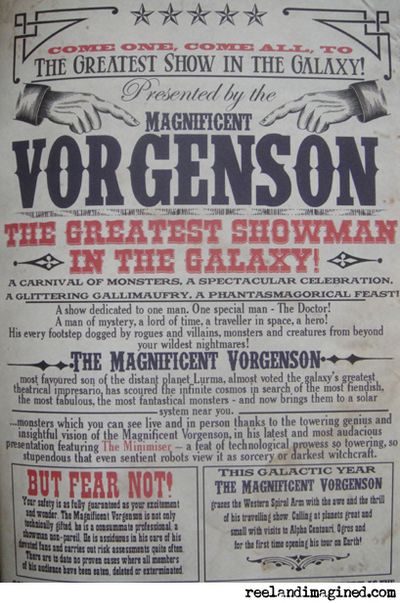
The show is in two 45-minute halves, and the first half suffers from being mostly Doctor-free. While Nigel Planer does a solid turn as Vorgenson, the matinee audience doesn’t really start responding to him until after the interval. Some of his lines were clearly written as responses that don’t seem to come, and for the first 30 minutes the atmosphere feels strangely flat whenever the monsters aren’t doing their thing out front.
Only when Matt Smith appears on the screen, in a filmed segment, and starts speaking directly to the crowd does the place start to heat up, even with the toasty pyro that flames up at the front of the stage from time to time. Smith’s dialogue seems much stronger than Planer’s, too.
It seems a mistake to leave the Doctor’s entrance so long, and during the interval I feel a bit deflated. The adverts promised me “all the magic of the television programme” but, so far, aside from the appearance of the Weeping Angels - an impressive segment that uses light and sound to bring the terror of the stone statues to the live environment - I’m not really feeling it. Something’s missing.

Since the show’s return in 2005, I’ve enjoyed hearing children talk about it; I’ve loved seeing their reactions to monsters at various exhibitions and events. In the hubbub of online fandom, where one false move by a writer, casting director or production designer can completely ruin the show for some folk, it’s always nice to see people of any age reacting to Doctor Who in ways that were intended, whether it’s crying for a character’s loss, cheering at their triumphs, or running away from their scary-looking mug.
So, buoyed by an eight-year-old’s trepidation, I approach the second half of the show with a renewed sense of wonder - not that I really need to. Part two is where all the best special effects lurk: the TARDIS materialises around the Doctor, a Cyberman is shot by a Dalek as sparks fly from his chestplate, and - best of all - a Dalek hovers 15ft above the stage with no visible means of support. The oohs and aahs for the last one might even put a spring in David Copperfield’s step.
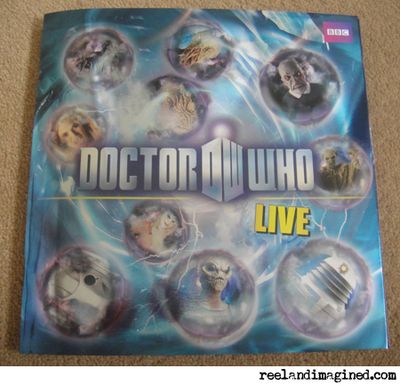
Ahem.
Doctor Who Live isn’t my idea of perfection - I’d like a richer script in places; a bigger, or at least earlier, role for the Doctor in part one; and a few monster replacements (I’m not a huge fan of the new Silurians, the Smilers or the Saturnynes) - but I do find it jolly good fun, once I locate my inner eight-year-old.
I’m not too sure where he was hiding, but wherever it was, I guarantee that it wasn’t behind my sofa.
